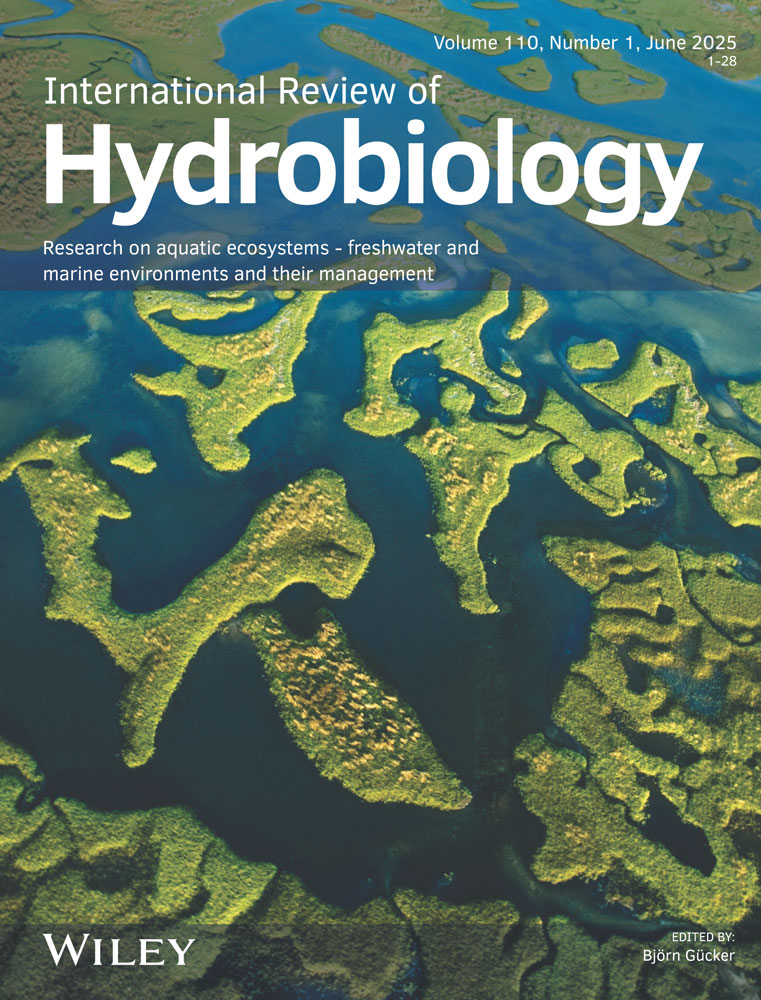Trichoptera, Odonata, and Diptera as Efficient Surrogate Taxa for Monitoring Macroinvertebrate Assemblages in Urban Amazonian Streams
ABSTRACT
Using a subset of the aquatic insect assemblage (e.g., Trichoptera, Odonata, and Diptera) and less refined identifications can reduce identification time and costs in aquatic biomonitoring. Using data collected from urban Amazonian streams, we evaluated the congruence between the macroinvertebrate fauna and the Trichoptera, Odonata, and Diptera subsets at the family and genus level. In addition, we evaluated the congruence between the abiotic and macroinvertebrate data sets. Data were collected during the dry and rainy seasons of 2004/2005 and the dry season of 2010. Our results indicate high intra-annual congruence for both abiotic and biotic (occurrence and abundance) variables. However, low interannual congruence was observed. Interannual congruence for biotic variables was slightly above 70%. Macroinvertebrate occurrence and abundance of all taxa showed a moderate correlation with abiotic data. The highest level of congruence with abiotic data was observed for the abundance of Odonata genera in 2010, while the lowest was found for the abundance of Diptera family in 2010. The concordance values between biotic and abiotic data were generally similar when considering both abundance and occurrence data. In all seasons, congruence between genera and families was greater than 90% for abundance and occurrence data. Our results suggest that assessments based on macroinvertebrate family abundance and occurrence may be sufficient for biomonitoring and that the families of Trichoptera, Odonata, and Diptera represent most of the total invertebrate assemblage in the streams studied.
1 Introduction
Human activities such as deforestation, sewage discharge, and natural resource exploitation can cause changes in the abiotic characteristics of streams (Liu et al. 2021; Lopes et al. 2021). For example, urbanization can lead to decreased oxygen levels, increased temperatures, and higher nutrient concentrations in streams (Lopes et al. 2015; Martins et al. 2015). Consequently, anthropogenic impacts have the potential to disrupt the diversity and structure of aquatic assemblages, resulting in a decrease in sensitive taxa and an increase in the dominance of tolerant taxa (Dala-Corte et al. 2020; Malacarne et al. 2024).
Various indices based on the sensitivity, structure, and composition of aquatic invertebrates have been proposed to assess the impact of human activities on aquatic fauna (Couceiro et al. 2012; Chen et al. 2017; Oliveira-Junior and Juen 2019). Although these indices have proven effective, their application may be limited by the time required for identification and screening at low levels (e.g., genera), which may be particularly challenging given the rapid degradation of aquatic ecosystems due to human activities. As a potential short-term solution, using surrogate taxa with sufficient sensitivity to represent the entire assemblage can help reduce the time required for faunal screening and identification (Valente-Neto et al. 2018, 2025; Alexandre et al. 2024).
In addition to spatial variation, invertebrate assemblage composition can also be influenced by temporal variation (Medupin 2020; Griffith and Kiffney 2022), which can sometimes mask the effects of environmental variables in biomonitoring studies (Santos et al. 2006). Intra-annual variability is typically associated with short-term changes in temperature and precipitation patterns (Mazor et al. 2009). During the rainy season, a decrease in abundance and richness is generally recorded, which is attributed to the transport of organisms and homogenization of substrates (Bispo et al. 2001; Brasil et al. 2018). In contrast, interannual variations are related to long-term changes in climatic conditions between years (Poff et al. 1997; Woodward et al. 2015) and can lead to changes in the invertebrate assemblages (Lepori and Malmqvist 2009; Mustonen et al. 2016). Understanding these temporal changes is critical for assessing the reliability of bioindicators and for evaluating how taxonomic resolution affects ecological assessments in dynamic freshwater ecosystems.
Concordance analysis assesses the degree of similarity in the composition of the taxonomic groups within the same location (Valente-Neto et al. 2016, 2018). This concordance can arise from various mechanisms, including biotic interactions or similar responses to environmental conditions (Paavola et al. 2003). It proves useful in environmental monitoring, as findings from one taxonomic group can be extended to others (Brito et al. 2018; Martins et al. 2022; Spigoloni et al. 2022; Valente-Neto et al. 2025), resulting in time and money savings.
In the present study, we selected three orders of aquatic insects based on their different sensitivity to environmental disturbances. Trichoptera are generally considered sensitive to environmental stressors and are strong indicators of undisturbed aquatic environments (Nessimian et al. 2008; Martins et al. 2017; De Paiva et al. 2017). Odonata show intermediate sensitivity, tolerating moderate levels of disturbance (Monteiro et al. 2014, 2016; Spigoloni et al. 2022). Diptera, particularly certain families (e.g., Chironomidae and Syrphidae), are more tolerant to environmental stress and can thrive in degraded conditions (Martins et al. 2017). This sensitivity gradient allows for a comprehensive environmental quality assessment across different stream conditions.
Given the potential of Trichoptera, Odonata, and Diptera as bioindicators, we aimed to evaluate their usefulness as surrogates for representing the broader aquatic insect fauna of Central Amazonian streams. We evaluated how concordance between two taxonomic resolutions (genus and family) and invertebrate assemblages and specific subsets of these assemblages changed intra- and inter-annually in response to abiotic variables. Previous studies conducted in urban streams in Manaus have yielded mixed results. Martins et al. (2017) observed a decrease in rarefied richness and an increase in EPT (Ephemeroptera, Plecoptera, and Trichoptera) richness and tolerant taxa from 2003 to 2010, while Couceiro et al. (2021) did not detect intra-annual variation in invertebrate richness, abundance, and composition. Therefore, we hypothesize that intra-annual data will show high congruence while interannual data will show lower congruence.
2 Materials and Methods
2.1 Study Area
Manaus has experienced rapid urban expansion since the 1970s, driven by industrial development, increasing the population from ~300,000 (1970) to 1.8 million (2010), with ~99% concentrated in urban areas. This led to uncontrolled land occupation along riverbanks, deforestation, siltation, and domestic sewage discharge (Bentes 2005; Couceiro et al. 2007; Martins et al. 2017).
We sampled 21 streams in the municipality of Manaus, Amazonas, Brazil (Figure 1) during both the dry season (November/December 2004) and the rainy season (May 2005), representing intra-annual variation. In addition, we collected data in September 2010 (dry season) to assess interannual variation in relation to the 2004/2005 data. All streams were sampled in each of the three seasons, with each stream being sampled only once per season. Streams were selected along a gradient of impact, with 13 streams affected by urbanization and/or deforestation and eight in forest remnants.
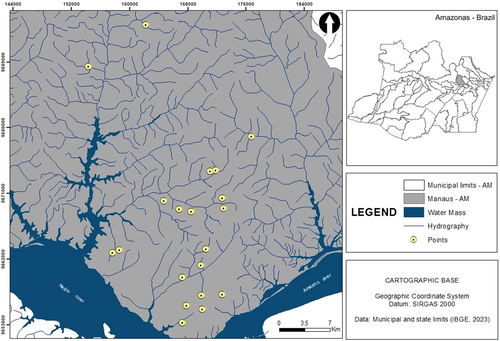
The climate of the Manaus region is classified as humid equatorial (Af according to the Köppen-Geiger classification), characterized by two distinct seasons: a rainy season from December to May and a dry season from June to November. The average annual temperature is 26.7°C, with monthly humidity ranging from 79% to 88%. The average annual rainfall is about 2300 mm.
2.2 Invertebrate Sampling
In each stream, we established a 60 m longitudinal transect. Along this transect, we collected samples at evenly spaced 15 m intervals (0, 15, 30, 45, and 60 m), using a “D” shaped aquatic entomological net (570 cm2, 1 mm2 mesh). Sampling was conducted in two microhabitats (sediment/edge litter and sediment/edge litter in the central stream bed), resulting in five samples per stream. Samples were preserved in plastic bags containing 90% ethanol and transported to the laboratory for processing. Upon arrival, samples were washed under running water through a metal sieve (125 µm mesh) and subsequently identified to the lowest taxonomic level possible using relevant literature (Hamada et al. 2019).
2.3 Abiotic Variables
We assessed stream depth and width using a ruler with millimeter markings. Water velocity was estimated by timing the passage of a plastic float over one meter. Electrical conductivity was measured with a portable meter (WTW, model LF90), and pH was recorded using a portable potentiometer (WTW, model pH90). Temperature and dissolved oxygen near the stream bottom were measured with a portable oximeter (YSI, model 55). Deforestation rates for each stream were determined using a 2003 Landsat satellite image, which was classified to distinguish forested and deforested areas within 100 m buffers around each stream's GPS-acquired geographic coordinates (Garmin).
2.4 Data Analysis
The congruence of intra- and interannual abiotic variables, aquatic invertebrates, and the relationship between biotic and abiotic variables was assessed using Procrustes analysis. This analysis compares two configurations obtained by ordination (Jackson 1995; Gower 2001). We used Procrustes analysis to examine the congruence between two datasets: (1) the abundance of invertebrate assemblages at the lowest possible taxonomic level, and (2) the abundance and occurrence (presence/absence data) of taxa at the family and genus levels. Specifically, we focused on Diptera (family level only), Odonata, and Trichoptera. For Procrustes analysis, we used the axis scores obtained from Principal Coordinates Analysis (PcoA; Legendre and Legendre 2012) with log-transformed (log (x + 1)) data to mitigate the influence of outliers. We applied Bray-Curtis dissimilarity for taxa abundance, Sørensen dissimilarity for taxa occurrence, and Euclidean dissimilarity for abiotic variables to quantify dissimilarities. The goodness of fit between matrices was assessed using the Procrustean permutation test (PROTEST). In this test, lower statistic values indicate higher concordance between groups (Peres-Neto and Jackson 2001). To determine the significance of these relationships in PROTEST, we performed 10,000 permutations. We performed all analyses in R (R Development Core Team 2024) using the vegan package (Oksanen et al. 2016).
3 Results
3.1 Abiotic Data
High congruence of abiotic data was observed within intra-annual seasons (81%; Figure 2). In contrast, the congruence between the abiotic data of 2010 and the dry (65%) and rainy (62%) seasons of 2004/2005 was moderate (Figure 2). These results indicate that the interannual variation in abiotic data in Amazonian urban streams exceeds their intra-annual variability.
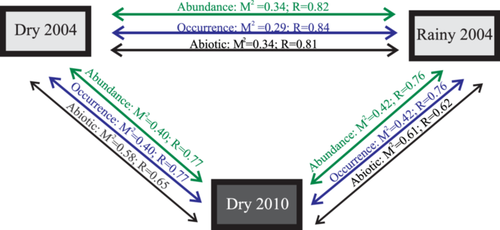
3.2 Biotic Data
In 2004/2005, we collected 13,910 specimens distributed across 77 taxa; in 2010, we collected 15,277 specimens distributed across 82 taxa (see Supporting Material). Diptera, Trichoptera, and Odonata accounted for 77% of the abundance and 61% of the observed richness in 2004/2005. By 2010, these three orders accounted for 53% of the abundance and 65% of the observed richness.
We found high intra-annual congruence in total fauna abundance (82%) and invertebrate occurrence (84%). The congruence of invertebrates between the 2010 data set and different seasons in the dry and rainy seasons of 2004/2005 was 77% and 76%, respectively, regardless of whether abundance or occurrence data were considered (Figure 2). In contrast to the abiotic data, these results suggest that there is relatively low variation in the invertebrate populations within and between the years in the urban streams studied.
3.3 Congruence: Invertebrates X Abiotic
The invertebrate occurrence and abundance (all taxa) datasets showed moderate correlation with the abiotic data across all three collection seasons (56%–70%; Figure 3). Most subsets showed similar levels of congruence with the abiotic data compared to the invertebrate data. The highest level of congruence with the abiotic data was observed in the abundance of the Odonata genera in 2010 (78%), while the lowest congruence was found in the abundance of the Diptera family in 2010 (42%; Figure 3). The macroinvertebrate abundance subset showed the least variation in congruence among the three collection seasons (2%). In contrast, Odonata genera (abundance = 29%; occurrence = 27%) showed the greatest variation in congruence between abiotic data and fauna across the three collection seasons. In general, concordance values between biotic and abiotic data were similar when considering abundance and occurrence data. These results suggest that overall, invertebrate family and occurrence data have a similar relationship with abiotic data compared to lower taxonomic levels. Additionally, Trichoptera, Odonata, and Diptera may have stronger associations with abiotic data than the full invertebrate assemblages from Amazonian urban streams.
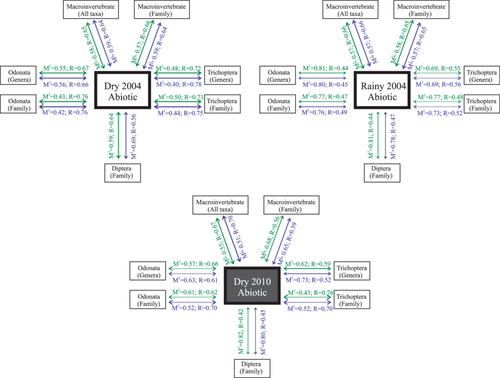
3.4 Congruence: Taxonomic Levels
In all seasons, the congruence between low-level invertebrates (genera) and families was greater than 93% for both abundance and occurrence data (Figure 4). Abundance and occurrence data for Trichoptera, Odonata, and Diptera genera and families were highly correlated (71%–96%) with the low-level invertebrate assemblage. The congruence between invertebrate abundance and occurrence data was greater than 94%. Occurrence data resulted in up to 7% loss of information compared to abundance data (Figure 4). Congruence was generally higher than 60% across all comparisons between years and seasons (Figure 5).
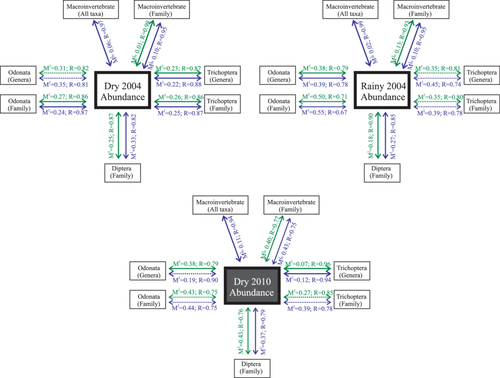
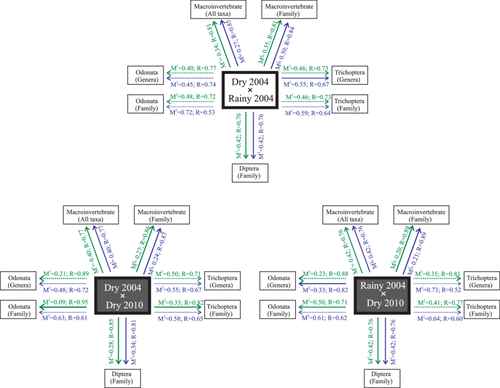
4 Discussion
We observed high intra-annual congruence for abiotic variables (deforestation rates, water velocity, electrical conductivity, pH, temperature, and dissolved oxygen) but low congruence between study years. In contrast, biotic data (occurrence and abundance) showed high intra- and interannual congruence. Using data identified at the family level or focusing on specific taxa groups (Trichoptera, Odonata, or Diptera) proved effective surrogates for the invertebrate assemblage. Furthermore, the use of occurrence data resulted in minimal loss of information compared to abundance data.
4.1 Abiotic Data: Intra- and Interannual Variation
We found high intra-annual congruence in abiotic variables in urban streams of Manaus. Seasonal abiotic variations include fluctuating water temperatures during the hot and rainy season and increased total organic carbon during the dry and cold season (Nava et al. 2015). Our study is consistent with previous findings in the region, which did not find significant differences in abiotic variables over the course of a year. Continuous sewage discharge into the streams studied may contribute to these small, transient changes in abiotic conditions during increased precipitation events (Santos et al. 2006).
We found moderate interannual congruence in abiotic variables in the urban streams of Manaus. Abiotic variables such as nitrogen, phosphorus, and oxygen show year-to-year variability influenced by precipitation patterns and land use changes (Atique and An 2020). Therefore, the observed low congruence between sampled years in urban streams of Manaus was expected and is consistent with previous studies in the region reporting increased environmental degradation due to deforestation and domestic sewage from a growing human population (Martins et al. 2017; Ferreira et al. 2021; Couto et al. 2024). These authors observed changes over time, including decreased oxygen levels and increased values of total nitrogen, total phosphorus, deforestation rates, total impervious area, water temperature, pH, and electrical conductivity.
4.2 Biotic Data: Intra- and Interannual Variation
Despite high variability in environmental variables between study years, invertebrate assemblages showed high intra- and interannual congruence. In general, these assemblages are affected by environmental changes (Brasil et al. 2020). However, previous studies in urban streams of Manaus did not record differences in invertebrate richness, abundance, or composition over time (Martins et al. 2017; Couceiro et al. 2021). Therefore, the observed high congruence may be related to the dominance of Chironomidae, Oligochaeta, and Psychodidae across collection years (median = 82% ± 26%) and within the same year (median = 80% ± 27%) in the urban streams of Manaus. The low intra- and interannual variation in invertebrate assemblages reinforces their utility as bioindicators due to their relative stability over time and low variability due to climatic factors (Holt and Miller 2011).
4.3 Biotic Data: Surrogates
We found that family and occurrence data can be a good proxy for genus-identified data, with minimal information loss of less than 10% across all collection seasons. Similar results have been reported for Amazonian stream invertebrates along an agricultural gradient (Brito et al. 2018; Martins et al. 2022) and Pantanal streams (Valente-Neto et al. 2018). This approach allows for efficient environmental assessment studies even in laboratories that lack expertise in some or all groups of aquatic invertebrates, thereby extending their applicability to a wider range of personnel. This inclusivity is crucial for conservation efforts in aquatic environments far from major research centers (Giehl et al. 2014; Brito et al. 2018). In addition, using occurrence data can reduce the time required for environmental assessments, as invertebrates often have high abundances (Martins et al. 2021). For instance, our study recorded an average of 1,253 individuals per stream in 2004/2005.
We found that Diptera, Odonata, and Trichoptera can be good proxies for low-level invertebrate identification data, with minimal information loss of less than 16%. Diptera, particularly the family Chironomidae, dominated all sampled streams due to their remarkable adaptability to different aquatic environments. Certain species within the genus Chironomus are highly tolerant to environmental impacts, while genera such as Stenochironomus are sensitive indicators of environmental conditions (Trivinho-Strixino 2011). Previous studies in the Amazon region have identified Odonata and Trichoptera as reliable indicators of aquatic invertebrate assemblages (Brito et al. 2018; Martins et al. 2022). Odonata exhibit extensive dispersal capabilities, and their two suborders, Anisoptera and Zygoptera, show different responses to environmental changes (Corbet 1999; Oliveira-Junior and Juen 2019). Trichoptera are typically associated with minimally disturbed environments and strongly correlate with riparian vegetation (de Faria et al. 2017). Although composite metrics incorporating multiple orders often better reflect disturbance gradients by integrating diverse environmental responses (Stanford 2012; Brito et al. 2018), focusing on a single order can be practical when specialists are not available for all groups, thereby increasing efficiency, reducing costs, and saving time in biomonitoring efforts (Valente-Neto et al. 2025).
5 Conclusion
Here, we conducted a first evaluation of concordance patterns between invertebrates in urban streams and different seasons in Amazonian streams. The selection of monitoring groups often prioritizes ease of collection and the availability of trained taxonomists. However, only a few groups are usually selected due to the scarcity of trained taxonomists. Therefore, demonstrating the efficacy of using these groups as surrogates for the full assemblage is necessary (Brown and Lomolino 1998; Uboni et al. 2019). Moreover, the choice of organism type should be consistent with the specific environment studied (e.g., lakes, streams, rivers). Concordance results between groups may vary regionally due to each region's unique climatic, geological, and vegetative conditions. Therefore, caution should be exercised when generalizing these results across different regions, as localized environmental factors may influence the degree of concordance.
Acknowledgments
We thank the Brazilian National Council for Scientific and Technological Development (CNPq) for granting a research productivity fellowship to N.H. (308970/2019-5) and K.D.S. (311550/2023-1). R.T.M. received a fellowship from Scientific and Technological Development (Biodiversa/FAPEAM), visiting researcher fellowships (380592/2022–3, 382557/2023-9), and PDS (101112/2024-6) from CNPq. The Amazonas State Research Foundation (FAPEAM) partially funded field sampling through the POSGRAD program and Biodiversa. We also thank the Universal/CNPq (403758/2021-1), Amazônia+10 initiative – CNPq/CONFAP/FAPEAM (400700/2024-7), and the INCT ADAPTA II, which is funded by CNPq (465540/2014-7), FAPEAM (062.1187/2017), and Coordination for the Improvement of Higher Education Personnel (CAPES). SRMC thanks UFOPA's research and technological development productivity fellowship program 2024-2025 (PQDT; call 06/2024).
Conflicts of Interest
The authors declare no conflicts of interest.



